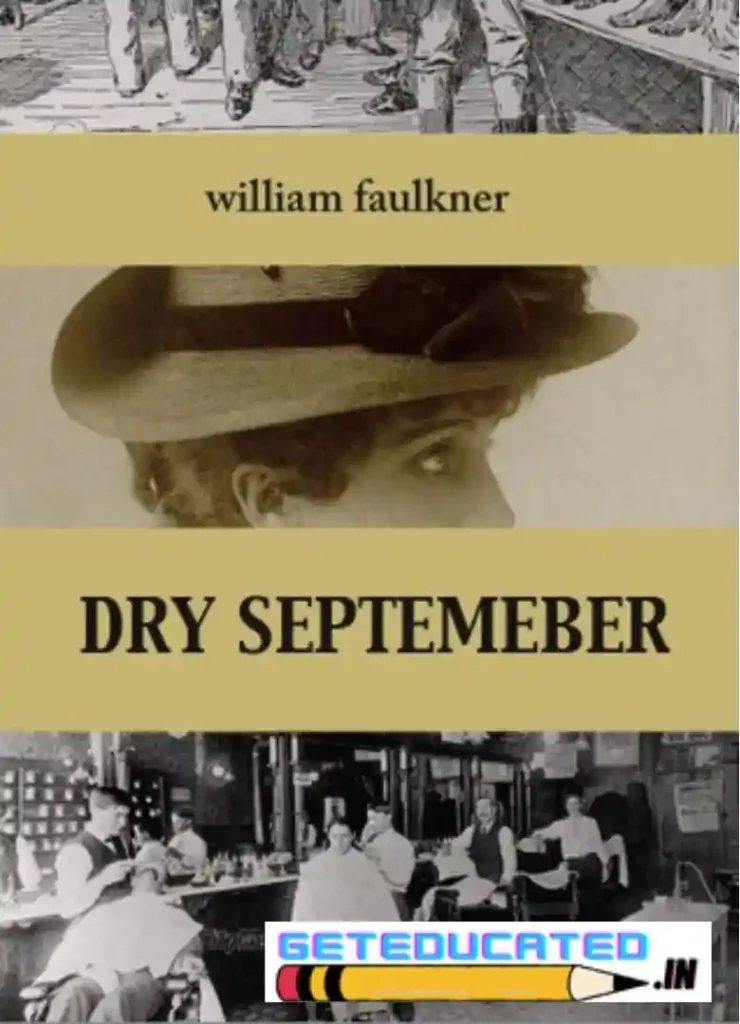
As a Southern writer, Faulkner draws upon the mores and prejudices of his own regional culture to create unforgettable characters and settings for his novels and short stories. “Dry September” clearly shows the horrible miscarriages of justice that prejudice can cause. Although the story revolves around the killing of Will Mayes, the actual act of killing is omitted in order to keep our attention focused on the causes of the violence, and on the mental and physical atmospheres that breed such senseless and random acts of cruelty.
The story is divided into five sections: Sections I and III show the town’s reaction to the rumor that Miss Minnie, a spinster, has been attacked by Will Mayes, a black man; Parts II and IV familiarize us with Miss Minnie’s history and give us an inside view of her emotional state; and Section V provides us with a glimpse of McLendon’s home life and his rebellious tyranny over his wife.
In this five part structure, with an utmost economy of expression and a refined and interesting style of storytelling “Dry September” sets a new style of short story genre. It is to be noted that the whole action of the story takes place in a single day- beginning from the “Bloody September twilight” of a Saturday in the barbershop to the Midnight of the same day when McLendon returns home after killing Will Mayes. Even the ending of “Dry September”, satisfies the criteria of as it leaves the readers in a dilemma to consider what will be the final fate of Mill Minnie or McLendon being parts of the murder of Will Mayes, directly or indirectly. The story has an open ending and successfully shows how one’s actions affects others on a day to day basis. Violence only produces more violence. Many movements and periods in history are the causes of society’s beliefs and convictions about race relations and individual’s
positions in society. Faulkner’s fiction, “Dry September,” also comments on how difficult it was to be a black man in the South to dwell when nearly the entire white population was against the black population. “Dry September” is indeed a passionate story that opens the eyes of society to the problems that lie underneath the surface.
The opening paragraph of “Dry September” sets the tone of the story by focusing on the oppressive heat and the resultant, uncontrolled and heated passions of Jefferson’s citizens. Sixty-two hot, rainless days have created a frustration among the townspeople and have fueled Miss Minnie’s accusation that she was raped by a black man. The first sentence stresses the rapidity with which the rumor — “like a fire in dry grass” — has spread throughout the town. The dry spell also causes the twilight to appear “bloody red,” which emphasizes the bloody events that are about to transpire. Already fueling people’s need for violence, the alleged attack has occurred in the early morning of the day that begins the story. Faulkner establishes a major theme by linking the rumor of Miss Minnie’s attack and the weather: Throughout the story, characters refer to the weather as an excuse for their behavior.
The first few paragraphs — typically Faulknerian with their long sentences of distorted but elaborate syntax — suggest another major theme, the questionable reliability of Miss Minnie’s accusation. The men assembled in the barbershop are unsure about the Southern woman’s claim: “Attacked, insulted, frightened: none of them . . . knew exactly what had happened,” or whether anything had happened at all. We must remember the discussion of the White Goddess concept as we form opinions about these men; it should surprise none of us that many characters, although they have their private doubts about the truthfulness of Miss Minnie’s claim, do nothing to question her or to stop the killing. Appropriately, the story begins in a barbershop, a symbolic gathering place for small-town gossipers. The spokesman
for quiet, calm justice is Henry Hawkshaw, one of the barbers. In his support of the accused Will Mayes, Hawkshaw is instantly on the defensive as he insists repeatedly that those men who want to act rashly should first find out the facts before they rush to judgment.
Throughout Section I, and later in Section III, Hawkshaw represents a concept of humane justice, but he proves ineffective when pitted against McLendon, who uses the Southern culture’s fears and prejudices to enrage men to commit violent acts. Hawkshaw’s sense of justice is no weapon against McLendon’s fierce bigotry. These two men represent diametrically opposed points of view: Hawkshaw is calm,
reasonable, and just; McLendon is wild, impassioned, and sadistic. Their opposition is best expressed when Hawkshaw, responding to McLendon’s goading of the men to join him in capturing Will Mayes, returns McLendon’s stare without flinching. Faulkner notes of the two men, “They looked like men of different races.”
The theme of justice or rather the lack of it is also explored in the story. By organising a lynch mob, McLendon is taking the law into his own hands and dispensing what he considers to be justice (killing Will Mayes). There is no sign of a trial or a presumption of innocence or investigation into what has happened, rather instead the men in the barber shop, along with McLendon, dispense a justice that they deem appropriate. Again this sense of justice is based on prejudice. Will is guilty simply because Minnie Cooper has suggested that he raped her and like other black people at the time the story was written, he would be considered to be at the bottom of the hierarchical system that was predominant in the South.
Faulkner also continues to explore the theme of gossip in section four of the story when the reader learns that Minnie Cooper’s friends appear to be more concerned about hearing all the details about what has happened Minnie rather than showing any genuine concern for her well-being. It is also interesting that Minnie appears to suffer a breakdown while she is in the movie theatre. Perhaps the reality of what she has done (lied about Will Mayes) has become too much for her. It would appear that Minnie’s main difficulty is that she is sexually repressed and by lying about Will Mayes raping her she has succeeded in people showing an interest in her again, however it is at the expense of Will Maye’s life. It would also appear that none of Minnie’s friends really believe that she has been raped. Just as Henry Hawkshaw doubted it, so too do Minnie’s friends.
Faulkner also appears to be using symbolism in the story, particularly the weather. In the first section of the story, Faulkner uses the word ‘dead’ to describe the air. This is significant as it in some ways acts as foreshadowing to what will happen Will Mayes later in the story. The opening line of the story also acts as foreshadowing to the eventual killing of Will Mayes, Faulkner using the word ‘bloody’ to describe the September twilight. Also in section three of the story Faulkner again describes the air, though this time uses the word ‘lifeless.’ He also describes the day as having ‘died in a pall of dust.’ This may be significant as Faulkner could be suggesting that the residents of Jefferson, particularly McLendon and the lynch mob are morally dead, by taking the law into their own hands.
Other notable symbolism in the story may include McLendon’s gun. It not only can be seen as a symbol of violence but it can be seen to represent violence in the past, present (possibly) and future. It is first introduced when McLendon walks into the barber shop, the reader learning that McLendon was a soldier in WWI (past violence). It is assumed the McLendon uses the gun to kill Will Mayes in section three of the story, which would suggest violence in the present and at the end of the story, McLendon puts the gun down on the table in his bedroom, which would suggest that it is to be used again, sometime in the future.
After Will’s death, the dust imagery seems almost soothing. The description of an all-encompassing dust suggests death’s immortality for Will. Also, it has a settling effect after the intensely violent action we know has happened: “The dust swallowed them; the glare and the sound died away. The dust of them hung for a while, but soon the eternal dust absorbed it again.” The “eternal” dust evokes our sympathy for Will and hints at an eternal afterlife for him. However, violence still lurks below the surface; nothing can forestall Miss Minnie’s hysteria and McLendon’s continuing rage.
The scene in the theater pits Miss Minnie against the unreality of the movie’s fantasy world, where life “began to unfold, beautiful and passionate and sad.” Her false sexuality is juxtaposed against the many pairs of young lovers, who enter the theater “scented and sibilant,” an image that again emphasizes the snake-like quality of Jefferson’s citizens. The movie represents an escape from life’s burdens, but, instead, Miss Minnie begins to laugh hysterically, implying that either she recognizes finally the futility of reclaiming a sexual identity or she might very well be suffering a nervous collapse, or both. The section ends with the friends undressing Miss Minnie and perversely examining her hair for signs of gray. Faulkner’s description of the friends’ eyes as “darkly aglitter, secret and passionate,” suggests that Miss Minnie is not the only Southern woman who is sexually repressed. Still wondering if the rape truly occurred, the women are not convinced of Miss Minnie’s accusations, but Will Mayes has had to pay for these charges with his life.
We return to the present and Miss Emily’s funeral. Her black servant meets the mourners, who arrive at the house, then he walks out the back door and disappears forever, apparently fully aware that Homer’s decayed body is upstairs .Even in death, Miss Emily cannot escape her father: “They held the funeral on the second day . . . with the crayon face of her father musing profoundly above the bier . . .” When the townspeople break into a locked room upstairs, they find carefully folded wedding clothes and Homer’s remains. Only after their initial shock at seeing his skeletal corpse do they notice an indentation on the pillow next to him, with a long strand of iron-gray hair lying where a head once rested.
Because Faulkner presents his story in random fragments, it is not until the final sentence that the entire picture of Miss Emily is complete. We realize that, having been denied male companionship by her father, she is desperate for human love, so desperate that she commits murder and then uses her aristocratic position to cover up that murder. But by killing Homer, she sentences herself to total isolation. With no possibility of contact with the living, she turns to the dead.
